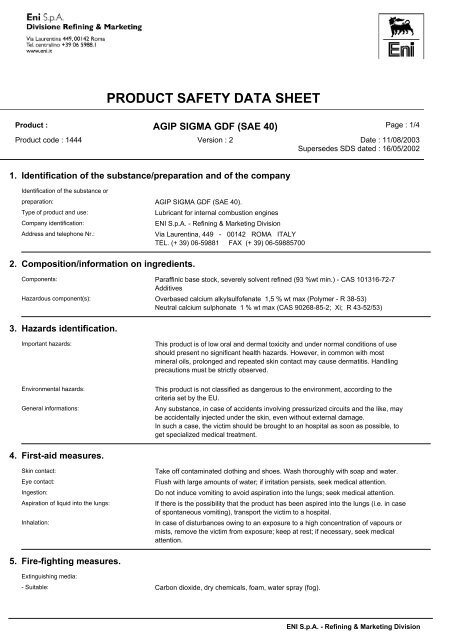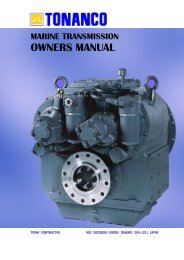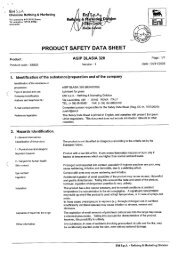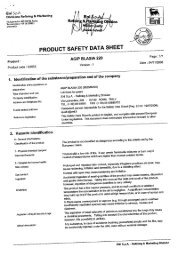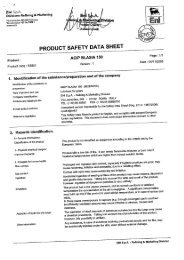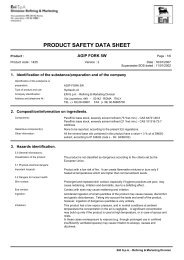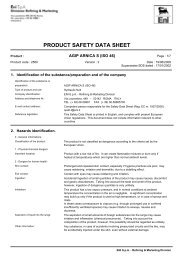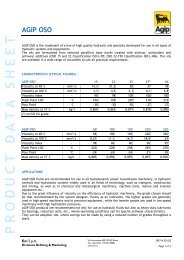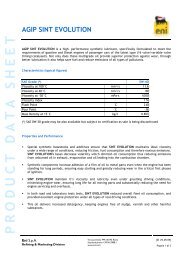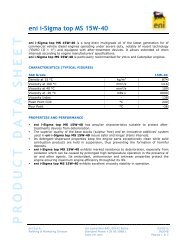AGIP SIGMA GDF (SAE 40) - TransDiesel
AGIP SIGMA GDF (SAE 40) - TransDiesel
AGIP SIGMA GDF (SAE 40) - TransDiesel
You also want an ePaper? Increase the reach of your titles
YUMPU automatically turns print PDFs into web optimized ePapers that Google loves.
PRODUCT SAFETY DATA SHEET<br />
Product : <strong>AGIP</strong> <strong>SIGMA</strong> <strong>GDF</strong> (<strong>SAE</strong> <strong>40</strong>)<br />
Page : 1/4<br />
Product code : 1444<br />
Version : 2<br />
Date : 11/08/2003<br />
Supersedes SDS dated : 16/05/2002<br />
1. Identification of the substance/preparation and of the company<br />
Identification of the substance or<br />
preparation: <strong>AGIP</strong> <strong>SIGMA</strong> <strong>GDF</strong> (<strong>SAE</strong> <strong>40</strong>).<br />
Type of product and use:<br />
Lubricant for internal combustion engines<br />
Company identification:<br />
ENI S.p.A. - Refining & Marketing Division<br />
Address and telephone Nr.:<br />
Via Laurentina, 449 - 00142 ROMA ITALY<br />
TEL. (+ 39) 06-59881 FAX (+ 39) 06-59885700<br />
2. Composition/information on ingredients.<br />
Components: Paraffinic base stock, severely solvent refined (93 %wt min.) - CAS 101316-72-7<br />
Additives<br />
Hazardous component(s): Overbased calcium alkylsulfofenate 1,5 % wt max (Polymer - R 38-53)<br />
Neutral calcium sulphonate 1 % wt max (CAS 90268-85-2; Xi; R 43-52/53)<br />
3. Hazards identification.<br />
Important hazards:<br />
This product is of low oral and dermal toxicity and under normal conditions of use<br />
should present no significant health hazards. However, in common with most<br />
mineral oils, prolonged and repeated skin contact may cause dermatitis. Handling<br />
precautions must be strictly observed.<br />
Environmental hazards:<br />
General informations:<br />
This product is not classified as dangerous to the environment, according to the<br />
criteria set by the EU.<br />
Any substance, in case of accidents involving pressurized circuits and the like, may<br />
be accidentally injected under the skin, even without external damage.<br />
In such a case, the victim should be brought to an hospital as soon as possible, to<br />
get specialized medical treatment.<br />
4. First-aid measures.<br />
Skin contact:<br />
Eye contact:<br />
Ingestion:<br />
Aspiration of liquid into the lungs:<br />
Inhalation:<br />
Take off contaminated clothing and shoes. Wash thoroughly with soap and water.<br />
Flush with large amounts of water; if irritation persists, seek medical attention.<br />
Do not induce vomiting to avoid aspiration into the lungs; seek medical attention.<br />
If there is the possibility that the product has been aspired into the lungs (i.e. in case<br />
of spontaneous vomiting), transport the victim to a hospital.<br />
In case of disturbances owing to an exposure to a high concentration of vapours or<br />
mists, remove the victim from exposure; keep at rest; if necessary, seek medical<br />
attention.<br />
5. Fire-fighting measures.<br />
Extinguishing media:<br />
- Suitable: Carbon dioxide, dry chemicals, foam, water spray (fog).<br />
ENI S.p.A. - Refining & Marketing Division
PRODUCT SAFETY DATA SHEET<br />
Product : <strong>AGIP</strong> <strong>SIGMA</strong> <strong>GDF</strong> (<strong>SAE</strong> <strong>40</strong>)<br />
Page : 2/4<br />
Product code : 1444<br />
Version : 2<br />
Date : 11/08/2003<br />
Supersedes SDS dated : 16/05/2002<br />
- Not to be used: Do not use water jets. They could cause splattering, and spread the fire.<br />
Other informations:<br />
Special protective equipment for firefighters:<br />
Useful precautions:<br />
6. Accidental release measures.<br />
General measures:<br />
Methods for cleaning up:<br />
Spilled product which is not burning should be covered with sand or foam<br />
Use water sprays to cool the surfaces exposed to the flames.<br />
Wear a suitable breathing apparatus if smoke is present.<br />
Avoid accidental sprays (i.e. from broken couplings) on hot surfaces or electrical<br />
contacts (switches, outlets and the like).<br />
In case of losses from pressurized circuits, the sprays may form oil mists. Take into<br />
account that the lower explosion limit for oil mists is about 45 g oil/m³ air.<br />
Shut off source of spill, if possible.<br />
- Soil: Contain spilled liquid with sand, earth or other suitable absorbents. Recover free<br />
liquid. Clean contaminated area. Dispose of according to local regulations.<br />
- Water: Confine the spillage. Remove from surface by skimming or suitable absorbents.<br />
Notify local authorities according to regulations.<br />
7. Handling and storage.<br />
Storage: Storage temperature: ambient to 65°C max .<br />
Handling:<br />
8. Exposure controls/personal protection.<br />
Exposure limits:<br />
Personal protection:<br />
- Open spaces: No special measures<br />
Store the product in cool, well ventilated surrounding.<br />
Keep away from sources of ignition.<br />
TLV-TWA (A.C.G.I.H. 2002): 5 mg/m³ (mineral oil mists)<br />
TLV-STEL (A.C.G.I.H. 2002): 10 mg/m³ (mineral oil mists)<br />
- Confined spaces: Aspirators in case of oil mist; protective shields, in case of oil splashes.<br />
Hand/eyes/skin protection:<br />
Hygiene measures:<br />
Mineral oil resistant gloves, overalls. Gloves must be felt-lined.<br />
Do not drink, eat or smoke with dirty hands.<br />
Wash hands before going to the toilet.<br />
Do not clean hands with dirty or oil-soaked rags.<br />
Change clothes if they are dirty or soaked, and in any case at the end of the working<br />
shift.<br />
Wash hands with water and soap, do not use solvents or other irritant products<br />
which have a defatting effect on the skin.<br />
9. Physical and chemical properties (typical values).<br />
Appearance: Liquid, bright & clear (ASTM D 4176/1).<br />
Odour:<br />
Characteristic.<br />
Colour Not determined (ASTM D 1500)<br />
Density a 15°C: 895 kg/m³ (ASTM D 1298).<br />
Boiling point/range: > 200 °C (at 10 mmHg) (ASTM D 1160)<br />
Vapour pressure:<br />
1·10-3 hPa (20 °C)<br />
Viscosity at 100°C : 14 mm²/s (ASTM D 445).<br />
ENI S.p.A. - Refining & Marketing Division
PRODUCT SAFETY DATA SHEET<br />
Product : <strong>AGIP</strong> <strong>SIGMA</strong> <strong>GDF</strong> (<strong>SAE</strong> <strong>40</strong>)<br />
Page : 3/4<br />
Product code : 1444<br />
Version : 2<br />
Date : 11/08/2003<br />
Supersedes SDS dated : 16/05/2002<br />
Solubility in water:<br />
Insoluble in water<br />
pH : Not applicable (ASTM D 1287).<br />
Pour point: -18 °C. (ASTM D 97)<br />
Flash point : 245 °C. (ASTM D 92)<br />
Auto-ignition temperature: > 300 °C (DIN 51794)<br />
Explosion limits:<br />
- Lower: Not determined.<br />
- Upper: Not determined.<br />
Partition coefficient (P o/w):<br />
Not determined.<br />
DMSO extract of base stock: < 3 % wt (IP 346/92)<br />
10. Stability and reactivity.<br />
Thermal decomposition products:<br />
Stability:<br />
Hazardous reactions:<br />
Materials to avoid:<br />
COx, HC<br />
Stable product.<br />
None<br />
Strong oxidants<br />
11. Toxicological information.<br />
Oral toxicity (rat):<br />
Dermal toxicity (rabbit):<br />
Inhalation toxicity (rat):<br />
Skin sensitization:<br />
Other informations:<br />
LD50 greater than 5000 mg/kg<br />
LD50 greater than 5000 mg/kg<br />
LC50 greater than 5 mg/l/4h<br />
The product is not classified as a sensitizer according to the criteria set by the EU.<br />
(Based on test with similar products).<br />
* Not irritating to eyes and skin<br />
* Minor irritation may occur after prolonged or repeated contact, especially if normal<br />
hygienic rules are not respected.<br />
* None of the components of this product are listed as carcinogen by NTP, IARC,<br />
OSHA, EU or others.<br />
12. Ecological information.<br />
General informations:<br />
This product is expected to be resistant to biodegradation and to persist in the<br />
environment.<br />
No specific environmental data are available for this product.<br />
According to the components, and by comparison with other products of the same<br />
type and composition, it is expected that this product has a toxicity for aquatic<br />
organisms > 100 mg/l, and must not be regarded as dangerous to the environment.<br />
Handle according to general working hygiene practices to avoid pollution and<br />
release into the environment.<br />
13. Disposal considerations.<br />
Disposal of product:<br />
European Waste Catalogue Code:<br />
Disposal of packaging:<br />
Do not dispose of the product, either new or used, by discharging into sewers,<br />
tunnels, lakes or water courses. Deliver to a qualified official collector.<br />
13 02 05 (Ref: 2001/118/CE)<br />
Dispose of in a safe manner, in accordance with local regulations.<br />
ENI S.p.A. - Refining & Marketing Division
PRODUCT SAFETY DATA SHEET<br />
Product : <strong>AGIP</strong> <strong>SIGMA</strong> <strong>GDF</strong> (<strong>SAE</strong> <strong>40</strong>)<br />
Page : 4/4<br />
Product code : 1444<br />
Version : 2<br />
Date : 11/08/2003<br />
Supersedes SDS dated : 16/05/2002<br />
14. Transport information.<br />
RID/ADR:<br />
ICAO/IATA:<br />
IMO-IMDG code:<br />
Does not belong to any class of danger.<br />
Does not belong to any class of danger.<br />
Does not belong to any class of danger.<br />
15. Regulatory information.<br />
Other indications:<br />
Applicable laws and regulations:<br />
Contains a sensitizer (Calcium sulphonate) in an amount > 0.1 % wt (Ref.: Dir.<br />
1999/45/CE)<br />
National laws on classification and labeling of dangerous substances/preparations<br />
(Adoption of Directive 67/548/CE and subsequent Adaptations to Technical<br />
Progress - ATP, and Directive 1999/45/CE).<br />
Relevant national laws on health and safety on the workplace.<br />
National adoption of Directives 89/391/CEE, 89/654/CEE, 89/655/CEE, 89/656/CEE,<br />
90/269/CEE, 90/270/CEE, 90/394/CEE, 90/679/CEE, 93/88/CEE, 95/63/CE,<br />
97/42/CE, 98/24/CE, 99/38/CE.<br />
National adoption of Directive 75/439/CEE concerning disposal of used oils.<br />
Relevant national laws on recycling and re-use of waste materials.<br />
Relevant national laws on prevention of water pollution.<br />
16. Other information.<br />
Nature of revision: Correction in Section: 2, 11, 12, 15.<br />
Adaption to new regulation: 1999/45/CE.<br />
Laboratory tests on animals have shown that engine oils undergo changes during<br />
usage, and risks increase, compared with fresh oils.<br />
Therefore, it is very important to follow the above mentioned precautionary<br />
measures also with used oils.<br />
This Safety Data Sheets conforms to the dispositions of the Directives 88/379/EC<br />
and 91/155/EC.<br />
This information relates only to the specific product and may not be valid if the product is used in combination with any other material<br />
or in any process.<br />
The informations in this sheet are according to our best knowledge at the date of printing.<br />
This Safety Data Sheet has been checked and printed on 12/08/2003.<br />
End of document. Number of page(s) : 4<br />
ENI S.p.A. - Refining & Marketing Division


